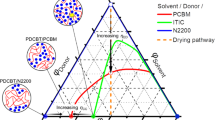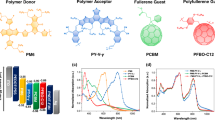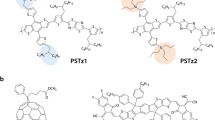Abstract
Low-cost photovoltaic energy conversion using conjugated molecular materials has become increasingly feasible through the development of organic ‘bulk heterojunction (BHJ)’ structures1,2,3,4,5,6,7, where efficient light-induced charge separation is enabled by a large-area donor–acceptor interface2,3. The highest efficiencies have been achieved using blends of poly(3-hexylthiophene) (P3HT) and a fullerene derivative8,9,10,11,12, but performance depends critically on the material properties and processing conditions. This variability is believed to be influenced by the self-organizing properties of P3HT, which means that both optical13,14 and electronic15,16 properties are sensitive to the molecular packing. However, the relationship between molecular nanostructure, optoelectronic properties of the blend material and device performance has not yet been demonstrated. Here we focus on the influence of polymer regioregularity (RR) on the molecular nanostructure, and hence on the resulting material properties and device performance. We find a strong influence of RR on solar-cell performance, which can be attributed to enhanced optical absorption and transport resulting from the organization of P3HT chains and domains. Further optimization of devices using the highest RR material resulted in a power conversion efficiency of 4.4%, even without optimization of electrodes7.
This is a preview of subscription content, access via your institution
Access options
Subscribe to this journal
Receive 12 print issues and online access
$259.00 per year
only $21.58 per issue
Buy this article
- Purchase on SpringerLink
- Instant access to full article PDF
Prices may be subject to local taxes which are calculated during checkout





Similar content being viewed by others
References
Tang, C. W. A two-layer organic solar cell. Appl. Phys. Lett. 48, 183–185 (1986).
Sariciftci, N. S., Smilowitz, L., Heeger, A. J. & Wudl, F. Photoinduced electron transfer from a conducting polymer to buckminsterfullerene. Science 258, 1474–1476 (1992).
Halls, J. J. M. et al. Efficient photodiodes from interpenetrating networks. Nature 376, 498–500 (1995).
Yu, G., Gao, J., Hummelen, J. C., Wudl, F. & Heeger, A. J. Polymer photovoltaic cells: enhanced efficiencies via a network of internal donor-acceptor heterojunctions. Science 270, 1789–1791 (1995).
Nelson, J. Organic photovoltaic films. Mater. Today 5, 20–27 (2002).
Brabec, C. J., Sariciftci, N. S. & Hummelen, J. C. Plastic solar cells. Adv. Funct. Mater. 11, 15–26 (2001).
Brabec, C. J., Shaheen, S. E., Winder, C., Sariciftci, N. S. & Denk, P. Effect of LiF/metal electrodes on the performance of plastic solar cells. Appl. Phys. Lett. 80, 1288–1290 (2002).
Schilinsky, P., Waldauf, C. & Brabec, C. J. Recombination and loss analysis in polythiophene based bulk heterojunction photodetectors. Appl. Phys. Lett. 81, 3885–3887 (2002).
Padinger, F., Ritterberger, R. S. & Sariciftci, N. S. Effects of postproduction treatment on plastic solar cells. Adv. Funct. Mater. 13, 85–88 (2003).
Kim, Y. et al. Device annealing effect in organic solar cells with blends of regioregular poly(3-hexylthiophene) and soluble fullerene. Appl. Phys. Lett. 86, 063502 (2005).
Reyes-Reyes, M., Kim, K. & Carroll, D. L. High-efficieny photovoltaic devices based on annealed poly(3-hexylthiophene) and 1-(3-methoxycarbonyl)-propyl-1-pheny-(6,6)C61 blends. Appl. Phys. Lett. 87, 083506 (2005).
Li, G. et al. High-efficiency solution processable polymer photovoltaic cells by self-organization of polymer blends. Nature Mater. 4, 864–868 (2005).
Brown, P. J. et al. Effect of interchain interactions on the absorption and emission of poly(3-hexylthiophene). Phys. Rev. B 67, 064203 (2003).
Zhokhavets, U., Gobsch, G., Hoppe, H. & Sariciftci, N. S. Anisotropic optical properties of thin poly(3-octylthiophene)-films as a function of preparation conditions. Synth. Met. 143, 113–117 (2004).
Sirringhaus, H. et al. Two-dimensional charge transport in self-organized, high mobility conjugated polymers. Nature 401, 685–688 (1999).
Kline, R. J. et al. Dependence of regioregular poly(3-hexylthiophene) film morphology and field-effect mobility on molecular weight. Macromolecules 38, 3312–3319 (2005).
Österbacka, R., An, C. P., Jiang, X. M. & Vardeny, Z. V. Two-dimensional electronic excitations in self-assembled conjugated polymer nanocrystals. Science 287, 839–842 (2000).
Choulis, S. A. et al. High ambipolar and balanced carrier mobility in regioregular poly(3-hexylthiophene). Appl. Phys. Lett. 85, 3890–3892 (2004).
Montanari, I. et al. Transient optical studies of charge recombination dynamics in a polymer/fullerene composite at room temperature. Appl. Phys. Lett. 81, 3001–3003 (2002).
Nelson, J. Diffusion-limited recombination in polymer-fullerene blends and its influence on photocurrent collection. Phys. Rev. B 67, 155209 (2003).
Guldi, D. M., Hungerbühler, H. & Asmus, K.-D. Redox and excitation studies with C60-substituted malonic acid diethyl esters. J. Phys. Chem. 99, 9380–9385 (1995).
Kim, Y. et al. Composition and annealing effects in polythiophene/fullerene solar cells. J. Mater. Sci. 40, 1371–1376 (2005).
Chirvase, D., Parisi, J., Hummelen, J. C. & Dyakonov, V. Influence of nanomorphology on the photovoltaic action of polymer-fullerene composites. Nanotechnology 15, 1317–1323 (2004).
Kim, Y. et al. Organic photovoltaic devices based on blends of regioregular poly(3-hexylthiophene) and poly(9,9-dioctylfluorene-co-benzothiadiazole). Chem. Mater. 16, 4812–4818 (2004).
Koller, G., Falk, B., Weller, C., Giles, M. & McCulloch, I. Process of preparing regioregular poly-(3-substituted) thiophenes. World patent WO2005/014691 (2005).
Hummelen, J. C. et al. Preparation and characterization of fulleroid and methanofullerene derivatives. J. Org. Chem. 60, 532–538 (1995).
Acknowledgements
The authors thank Merck Chemicals for supplying the P3HT polymer and British Petroleum International for financial support through the OSCER project. Y.K. thanks G. Y. Heo (Postech, Korea), J. W. Park and H. J. Kim (PNU, Korea) for their help with the GIXRD and SEM measurements.
Author information
Authors and Affiliations
Corresponding authors
Ethics declarations
Competing interests
The authors declare no competing financial interests.
Supplementary information
Supplementary Information
Supplementary table S1 and figure S1 (PDF 47 kb)
Rights and permissions
About this article
Cite this article
Kim, Y., Cook, S., Tuladhar, S. et al. A strong regioregularity effect in self-organizing conjugated polymer films and high-efficiency polythiophene:fullerene solar cells. Nature Mater 5, 197–203 (2006). https://doi.org/10.1038/nmat1574
Received:
Accepted:
Published:
Issue Date:
DOI: https://doi.org/10.1038/nmat1574



